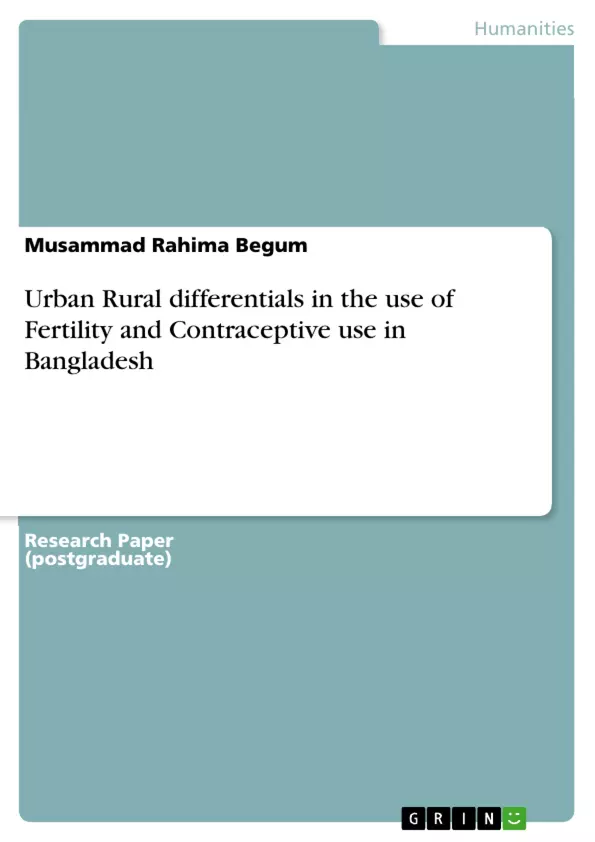Bangladesh is the one of the most populous country in the world being able to make the world, the demographers and population scientists to look at this country with marvel eyes to see the staggering improvement in fertility declining. Without substantial improvement in socio-economic and health the extent and rapid declining fertility started from mid seventieth to mid nineteenth, and then remained constant over a decade. Bangladesh is now walking to attaining replacement level of fertility as the fertility declining again started from the mid twentieth and has been carrying the declining in fertility through all over the last decade. Along with achieving the long and glorious history of fertility declining Bangladesh also experienced an intensive increase in contraceptive use over these periods.
This paper has been made an attempt to explore the rural urban differentiate of fertility and contraceptive use in Bangladesh adopting parity progression ratio and logistic regression model using the nationwide Bangladesh Demographic and Health Survey data. The findings indicate that urban area has an improvement in fertility and contraceptive use than their rural counterparts. Age of the respondent, level of education, region, and current work status are significant predictors of current use of contraception in urban area. In rural area the significant predictors are age of the respondent, level of education, region, current work status, exposure to mass media and religion.
Inhaltsverzeichnis (Table of Contents)
- 1. INTRODUCTION
- 2. DATA AND METHODOLOGY
- 3. RESULTS AND DISCUSSION
- 3.1 Urban rural differentials in fertility through Parity Progression ratio
- 3.2 Urban Rural differentials in the use of contraception
- 4. Conclusions
- 5. REFERENCES
Zielsetzung und Themenschwerpunkte (Objectives and Key Themes)
This paper investigates the differentials in fertility and contraceptive use between urban and rural areas in Bangladesh. The study analyzes data from the 2007 Bangladesh Demographic and Health Survey (BDHS-2007) to assess these disparities and identify the factors contributing to them. It uses the Parity Progression Ratio (PPR) to explore the urban-rural gap in fertility and applies binary logistic regression to identify factors influencing contraceptive use.
- Urban-Rural Differentials in Fertility
- The Role of Contraceptive Use in Fertility Declines
- Factors Influencing Contraceptive Use
- The Impact of Place of Residence on Fertility and Contraceptive Use
- The Role of Socioeconomic Factors in Fertility and Contraceptive Use
Zusammenfassung der Kapitel (Chapter Summaries)
The introduction establishes the context for the study, highlighting the significance of population growth in Bangladesh and the role of fertility decline in mitigating its impact. It also outlines the importance of contraceptive use and the observed disparities between urban and rural areas in fertility and contraceptive uptake.
Chapter 2 details the data and methodology employed in the study. It describes the use of the 2007 Bangladesh Demographic and Health Survey (BDHS-2007) as the primary source of data, and explains the application of the Parity Progression Ratio (PPR) to analyze fertility differentials and binary logistic regression to identify factors influencing contraceptive use.
Chapter 3 presents the findings and discussion of the study. Section 3.1 analyzes the urban-rural differences in fertility using the Cohort Parity Progression Ratio (CPPR) and the Period Parity Progression Ratio (PPPR). It examines the trends in fertility across different parity transitions and explores the reasons behind the observed disparities. Section 3.2 delves into the factors influencing contraceptive use in both urban and rural areas, employing binary logistic regression to identify significant predictors of contraceptive use, including age, education, region, working status, media exposure, wealth index, and religion.
Schlüsselwörter (Keywords)
The study focuses on the key themes of fertility, contraceptive use, urban-rural differentials, Parity Progression Ratio, and the influence of socioeconomic factors. The research uses data from the Bangladesh Demographic and Health Survey (BDHS-2007) to analyze these themes and draw conclusions about the disparities in fertility and contraceptive use between urban and rural areas in Bangladesh.
- Quote paper
- Musammad Rahima Begum (Author), 2017, Urban Rural differentials in the use of Fertility and Contraceptive use in Bangladesh, Munich, GRIN Verlag, https://www.hausarbeiten.de/document/380368


